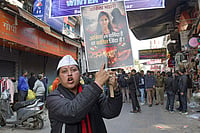
According to the Centre for Asia Pacific Aviation (CAPA), domestic passenger traffic, up 25 per cent to 19 million in the year ended March 31, 2005, will vault to somewhere between 45 and 50 million by 2010. International traffic, which increased 20 per cent to 17-18 million in 2004-05, is projected to be between 30-35 million by that time. The number of aircraft on domestic routes will increase from 180 at present to 450, about half of which will be with low-cost carriers. Significantly, the effects of 9/11, which had seen US-based United and Delta discontinuing their services to India, may finally be wearing off. Continental Airlines, the world's sixth largest, announced this week that it will start a daily non-stop service from New Delhi to New York on November 1 this year.
"We foresee an investment of $25 billion in Indian aviation over the next five years. In addition, there will be $5-6 billion invested in general aviation such as helicopters and corporate aircraft," says Kapil Kaul, CAPA's CEO for the Indian subcontinent and Middle East.
New airlines in the pipeline are Kingfisher Air of Vijay Mallya's UB Group, Air India Express (A-I's low-cost carrier), Spice Jet (erstwhile ModiLuft), Go Air of the Wadias of Bombay Dyeing, Magic Air, Crystal Air, Indus Air and Paramount Airways. Five more are understood to be in the planning stage and East West is being revived. Jet and Sahara, both taking their first steps into international aviation, are augmenting their fleet by adding long-haul aircraft.
All this could well be a frequent flier's nightmare given that packed airport lounges are already common and Delhi-bound planes are advised to carry an extra half-hour's fuel. Fortunately, a new era may soon dawn on airports too. Greenfield international airports are under construction at Bangalore and Hyderabad in public-private partnership. On March 31, tenders were floated for modernisation of the Delhi and Mumbai airports. "We are also improving the air traffic control procedures, constructing high-speed taxiways and trying to shift some traffic in Mumbai from Santa Cruz to Juhu," says Prasad.
How will IA and A-I face this changed scenario?
A-I, exhibiting typical Indian ingenuity, had taken to making money out of not flying! Unable to utilise its flying rights earned under bilateral arrangements (its fleet is less than one-tenth that of the major international carriers), it had taken to selling the rights, making about Rs 350 crore a year. The government, after consulting the A-I board, has decided to phase out this practice in five years. "It was giving us a bad name. Internationally, this is just not done. Airlines should earn by flying, not by not flying," says Prasad.
The intent now is to maximise the use of rights. (The current utilisation is less than 40 per cent.) In keeping with this, the government has put fleet expansion by both A-I and IA on the fast track.

A-I has already identified the Boeing 737-800 as its choice for A-I Express, the low-cost carrier which takes off on April 29. The acquisition is likely to get the government's go-ahead soon. Besides, A-I is looking to acquire some 250-seater, 350-seater and ultra-long-range aircraft for which Boeing and Airbus have put in bids. Financial evaluation of the bids is under way. A-I's board meeting scheduled for later this month may take a final view. IA has already identified Airbus Industrie as its supplier. Delivery starts in 18 months. The government is also supportive of IA's proposed IPO.
Aircraft acquisition is crucial for both. Until IA and A-I acquired some planes on lease recently (purchase is cheaper, but delays due to government procedures were hurting), the average age of both fleets was 17 years against the global average of about seven. That translates into higher costs, higher risks and lower reputation.
The expert view, however, is that more drastic measures are needed, such as a merger of the two. Then, A-I could service the overseas routes, and IA, which now flies to some foreign destinations, could stop competing with its sibling and stick to domestic flights. And Alliance Air, which is now confined to trunk routes, could become a low-cost carrier. "Both carriers need to work for each other and not against each other. Synergies between these two can result in millions of dollars of savings and help them face the intense competition," says Kaul.
Will the government, all newfound reformist fervour, fly this route?


























